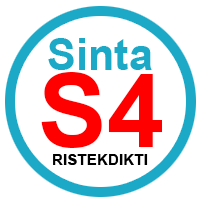Analisis Faktor-fakor yang Mempengaruhi Literasi Keuangan Mahasiswa Akuntansi Universitas Sarjanawiyata Tamansiswa di Masa Pandemi Covid-19
Abstract
Penyebaran virus Covid 19 telah mengguncang perekonomian di berbagai negara, termasuk Indonesia. Hal ini disebabkan masih minimnya literasi keuangan di masyarakat yang dimulai dari fase dewasa muda, khususnya pada pelajar atau mahasiswa. Masalah keuangan dapat menyebabkan stres, dan sekitar 74% mahasiswa pada komunitas di kampus melaporkan mengalami kesulitan terkait keuangan, Tujuan dari penelitian ini adalah untuk mengetahui sejauh mana faktor-faktor yang mempengaruhi literasi keuangan seperti sikap keuangan, lingkungan keluarga, tekanan teman sebaya dan efikasi keuangan. Jenis penelitian ini adalah penelitian kuantitatif dengan pendekatan deskriptif. Sampel yang diteliti adalah seluruh S1 Fakultas Ekonomi Program studi Akuntansi Universitas Sarjanawiyata Tamansiswa, pengambilan sampel dalam penelitian ini menggunakan purposive sampling, sehingga dengan menggunakan perhitungan diatas diketahui populasi sebanyak 250 mahasiswa maka diambil sampel sebanyak 155 mahasiswa yang digunakan dalam penelitian ini. Teknik analisis data dalam penelitian ini menggunakan uji validitas, uji reliabilitas dan uji model struktural. Hasil penelitian ini menunjukkan bahwa faktor lingkungan keluarga tidak berpengaruh signifikan terhadap literasi keuangan, sedangkan faktor efikasi keuangan Berpengaruh signifikan terhadap literasi keuangan, sikap keuangan Berpengaruh signifikan terhadap literasi keuangan, dan tekanan teman sebaya memiliki pengaruh yang signifikan terhadap literasi keuangan. Hal ini sesuai dengan penelitian (Thomas & Subhashree, 2020) bahwa pengetahuan keuangan, sikap keuangan, pengaruh orang tua, dan teman sebaya berpengaruh langsung dan positif terhadap tingkat literasi keuangan pada mahasiswa S1 Teknik.
References
Ajzen, I. (2012). The theory of planned behavior. Handbook of Theories of Social Psychology: Volume 1, 50, 438–459. https://doi.org/10.4135/9781446249215.n22
Al-Tamimi, H. A. H., & Bin Kalli, A. A. (2009). Financial literacy and investment decisions of UAE investors. The Journal of Risk Finance, 10(5), 500–516.
Alhabeeb, M. J. (1999). Allowances and the economic socialization of children.
Association for Financial Counseling and Planning Education, 10(2), 1–9.
Amagir, A., Groot, W., van den Brink, H. M., & Wilschut, A. (2020). Financial literacy of high school students in the Netherlands: knowledge, attitudes, self-efficacy, and behavior. International Review of Economics Education, 34(February), 100185. https://doi.org/10.1016/j.iree.2020.100185
Amatucci, F. M., & Crawley, D. C. (2011). Financial self-efficacy among women entrepreneurs. International Journal of Gender and Entrepreneurship, 3(1), 23–37. https://doi.org/7. https://doi. org/10.1108/17566261111114962
Andrews, B., Wilding, J. M. (2004). The relation of depression and anxiety to life‐ stress and achievement in students. Br. J. Psychol, 95(4), 509–521.
Anthes, W. L. (2004). Frozen in the headlights: The dynamics of women and money. Journal of Financial Planning, 13(9), 130–142.
ASIC. (2003). Summary of stakeholder responses to financial literacy in schools,.
ASIC Discussion Paper, June 2003.
Atkinson, A., & Messy, F. A. (2012). Measuring financial literacy: Results of the OECD/International Network on Financial Education (INFE) pilot study. Retrieved from https://www.oecd-ilibrary.org/docserver/5k9csfs90fr4-en pdf%0A?expires=1547457090&id=id&accname=guest&checksum=%0AFD9 322B38CB025C91153D94767BA7924
Aydin, A. E., & Akben Selcuk, E. (2019). An investigation of financial literacy, money ethics and time preferences among college students: A structural equation model. International Journal of Bank Marketing, 37(3), 880–900. https://doi.org/10.1108/IJBM-05-2018-0120
Bandura, A. (1977). Self-efficacy: toward a unifying theory of behavioral change. E. Psychological Review, (84), 191–215.
Bandura, A. (1994). Self-efficacy. In V.S. Ramachaudran (Ed.). Encyclopedia of Human Behaviour.
Bandura, A. (2005). The evolution of social cognitive theory. In K. G. Smith, & M. A. Hitt (Eds.),. (Oxford, Ed.), , Great Minds in Management. University Press.
Bandura, A. (2006). Guide for constructing self-efficacy scales. In F. Pajares & T.C. Urdan (Eds.),. In Self-Efficacy Beliefs of Adolescents (p. (pp. 307– 337).). Greenwich, CT: Information Age Publishing.
Beutler, I. F., & Dickson, L. (2008). Consumer economic socialization. In J. J. Xiao (Ed.). In Handbook of consumer finance research (pp. 83–102). New York: Springer.
Bhushan, P., & Medury, Y. (2014). An empirical analysis of inter linkages between financial attitudes, financial behavior and financial knowledge of salaried individuals. Indian Journal of Commerce and Management Studies, 5(3), 58.
Brown, B. B., Mounts, N., Lamborn, S. D., & Steinberg, L. (1993). Parenting practices and peer group affiliation in adolescence. Child Development, (64), 467–482.
Chinen, K., & Endo, H. (2012). Effects of attitude and background on personal financial ability: A student survey in the United States. International Journal of Management, 29(1), 33.
Choi, J. J., Laibson, D., & Madrian, B. C. (2010). Why does the law of one price fail? An experiment on index mutual funds. The Review of Financial Studies, 23(4), 1405–1432.
Clarke, M. D., Heaton, M. B., Israelsen, C. L., & Eggett, D. L. (2005). The acquisition of family financial roles and responsibilities. Family and Consumer Sciences Research Journal, (33), 321–340.
Dangol, J., & Maharjan, S. (2018). Parental and Peer Influence on the Saving Behavior of the Youth. International Research Journal of Management Science, 3(1), 42–63. https://doi.org/10.3126/irjms.v3i0.28035
Farrell, L., Fry, T. R. L., & Risse, L. (2016). The significance of financial self- efficacy in explaining women’s personal finance behaviour. Journal of Economic Psychology, 54, 85–99. https://doi.org/10.1016/j.joep.2015.07.001
Ghozali, I. (2014). Structural Equation Modeling Metode Alternatif dengan Partial Least Square (Edisi 4). Semarang: Badan Penerbit Universitas Diponegoro.
Gratz, J. (2006). The impact of parents’ background on their children’s education. Educational Studies, 1(12), 268.
Haque, A., & Zulfiqar, M. (2015). Women’s economic empowerment through financial literacy, financial attitude and financial wellbeing. Research Journal of Finance & Accounting, 6(21), 57–66.
Harris, J. R. (1995). Where is the child’s environment? A group socialization theory of development. Psychological Review, (102), 458–489.
Heckman, S., Lim, H., Montalto, C. (2014). Factors related to financial stress among college students. J. Financ. Ther, 5(1), 19–39.
Huston, S. (2010). Measuring Financial Literacy. Journal of Consumer Affairs, (44), 296–316. https://doi.org/http://dx.doi.org/10.1111/j.1745- 6606.2010.01170.x
Ibrahim, M. E., & Alqaydi, F. R. (2013). Financial literacy, personal financial attitude, and forms of personal debt among residents of the UAE. International Journal of Economics and Finance, 5(7), 126.
Institute, T.-C. (2001). 2001 parents, youth & money survey: Parents miss the mark as financial educators for their kids. Retrieved from rethttp://www.tiaacrefinstitute.org/about/news/ym_survey.html
John, D. R. (1999). Consumer socialization of children: a retrospective look at twenty-five years of research. The Journal of Consumer Research, (26), 183–213.
Jorgensen, B. L., & Savla, J. (2010). Financial literacy of young adults: The importance of parental socialization. Family Relations, (59), 465–478.
Lusardi, A. (2008). inancial Literacy: an Essential Tool for Informed Consumer Choice? Ational Bureau of Economic Research.
Mahrunnisya, D., Indriayu, M., Wardani, D. K. (2018). Peer conformity through money attitudes toward adolescence’s consumptive behavior. International Journal of Multicultural and Multireligious Understanding, 5(4), 30–37.
Marlatt, G. . (1985). Controlled drinking: the controversy rages on. American Psychologist, (40), 374–375.
Mowen, J.C., Minor, M. S. (2000). Consumer Behaviour: A Framework. Englewood Cliffs,. New Jersey: Prentice Hall.
Mugenda, O. M., Hira, T. K., & Fanslow, A. M. (1990). . Assessing the causal relationship among communication, money management practices, satisfaction with financial status, and satisfaction with quality of life. Lifestyles: Family and Economic Issues, (11), 343–360.
Munoz-Murillo, M., Alvarez-Franco, P. B., & Restrepo-Tobón, D. A. (2020). The role of cognitive abilities on financial literacy: New experimental evidence. Journal of Behavioral and Experimental Economics, 84, 1–21. https://doi.org/https://doi.org/10.1016/j.socec.2019.101482
Murdock, T. B., Hale, N. M., & Weber, M. J. (2001). Predictors of Cheating among Early Adolescents: Academic and Social Motivations. Contemporary Educational Psychology, 26(1), 96–115. https://doi.org/10.1006/ceps.2000.1046
OECD. (2013). Financial literacy and inclusion: Results of OECD/INFE survey across countries and by gender. Paris: OECD Centre.
Remund, D. L. (2010a). Financial literacy explicated: The case for a clearer definition in an increasingly complex economy. Journal of Consumer Affairs, 44(2), 276–295.
Sandler, M. E. (2000). Career Decision-Making Self-Efficacy, Perceived Stress, and an Integrated Model of Student Persistence: Research in Higher Education, 41(5), 537–580.
Santrock, J. W. (2003). Adolescence. Jakarta: Erlangga.
Stajkovic, A.D. & Luthans, F. (1998). Self-efficacy and work-related performance: a meta-analysis. S. Psychological Bulletin, (124), 240–261.
Thomas, B., & Subhashree, P. (2020). Factors that influence the financial literacy among engineering students. Procedia Computer Science, 172(2019), 480– 487. https://doi.org/10.1016/j.procs.2020.05.161
Webley, P. & Nyhus, K. E. (2006). Parents’ influence on children’s future orientation and saving. Journal of Economic Psychology, 27(1), 140–164.
Xiao, J.J., Ahn, S.Y., Serido, J. and Shim, S. (2014). Earlier financial literacy and later financial behaviour of college students. International Journal of Consumer Studies, 38(6), 593–601.
Youniss, J., & Haynie, L. D. (1992a). Friendship in adolescene. Journal of Developmental & Behavioral Pediatrics, 13(1), 59–66.

This work is licensed under a Creative Commons Attribution-NonCommercial 4.0 International License.







